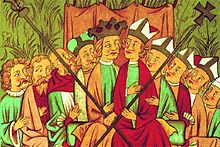Veche

Veche (Russian: вече, Polish: wiec) was a popular assembly in medieval Slavic countries, and in late medieval period, often compared to a parliament.
The word "veche/wiec" is derived from a Proto-Slavic root *vēt-, meaning `council' or `talk' (which is also represented in the word "soviet")[1]. The semantic derivation that yields the meaning of the word under consideration is parallel to that of parliament.
Kievan Rus
The East Slavic veche is thought to have originated in tribal assemblies of Eastern Europe, thus predating the Rus' state. It is not clear whether it was a purely Slavic development or it was based on the model of the Varangian Ting. The authority of the veche appears to have been stronger in the north, where the tradition of the Rus' Khaganate lived on.
The earliest mentions of veches in Russian chronicles refer to examples in Belgorod-on-the-Dnieper in 997, Novgorod the Great in 1016 and in Kiev in 1068. The assemblies discussed matters of war and peace, adopted laws, and called for and expelled rulers. In Kiev, the veche was summoned in front of the Cathedral of St Sophia.
Veche in the Novgorod and Pskov Republics

According to the traditional scholarship, the veche was the highest legislature and judicial authority in the Republic of Novgorod until 1478, when the city was brought under the direct control of Grand Prince Ivan III (1462-1505). In its "Little Brother", Pskov the veche continued until 1510, when that city was taken over by Grand Prince Vasilii III (1505-1533).
The traditional scholarship goes on to argue that a series of reforms in 1410 transformed the veche into something similar to the public assembly of Venice; it became the Commons or lower chamber of the parliament. Аn upper Senate-like Council of Lords (sovet gospod) was also created, with title membership for all former city magistrates (posadniks and tysyatskys). Some sources indicate that veche membership may have became full-time, and parliament deputies were now called vechniks. Some of the more recent scholars call this interpretation into question.
The Novgorod assembly could be presumably summoned by anyone who rung the veche bell, although it is more likely that the common procedure was more complex. The whole population of the city - boyars, merchants, and common citizens - then gathered at Yaroslav's Court or in front of the Cathedral of Holy Wisdom (the latter called a Vladychnoe veche - "An Archbishop's Veche," since it was called in front of the cathedral). The veche bell was a symbol of republican sovereignty and independence and for this reason, Ivan III carted it off to Moscow when he took control of the city, to show that the old way of doing things was at an end.
Separate assemblies could be held in the boroughs or "Ends" of Novgorod. In Pskov the veche assembled in the court of the Trinity cathedral.
Poland

According to the Chronicles of Gallus Anonymus, the first legendary Polish ruler, Siemowit, who began the Piast Dynasty, was chosen by a wiec. The idea of the wiec led in 1182 to development of the Polish parliament, the Sejm.
Yugoslavia
In Yugoslavia this word was used for the houses of the Yugoslavian parliament - veće/веће (slightly different pronunciation with ch being softer than the one in Russian language).
References
- Michael C. Paul, "The Iaroslavichi and the Novgorodian Veche: A Case Study on Princely Relations with the Veche," Russian History (2004).
See also
- Ting (Scandinavian popular assembly)
- Sejm in Poland, Seimas in Lithuania, Saeima in Latvia
- Rada (later kind of popular assembly, then the parliament of Ukraine)
- Duma and Zemsky Sobor (the Russian parliaments)
Notes
- ^ See the Slavic etymology of the word and the corresponding references in the following entries of the Max Vasmer's Etymological dictionary:
- of the particular word вече/veche Template:Ru icon,
- of the basic root вѣт- Template:Ru icon,
- and the possible further Indo-European etymology of this root in the entry
- all of them presented online in the etymological databases of The Tower of Babel project.
